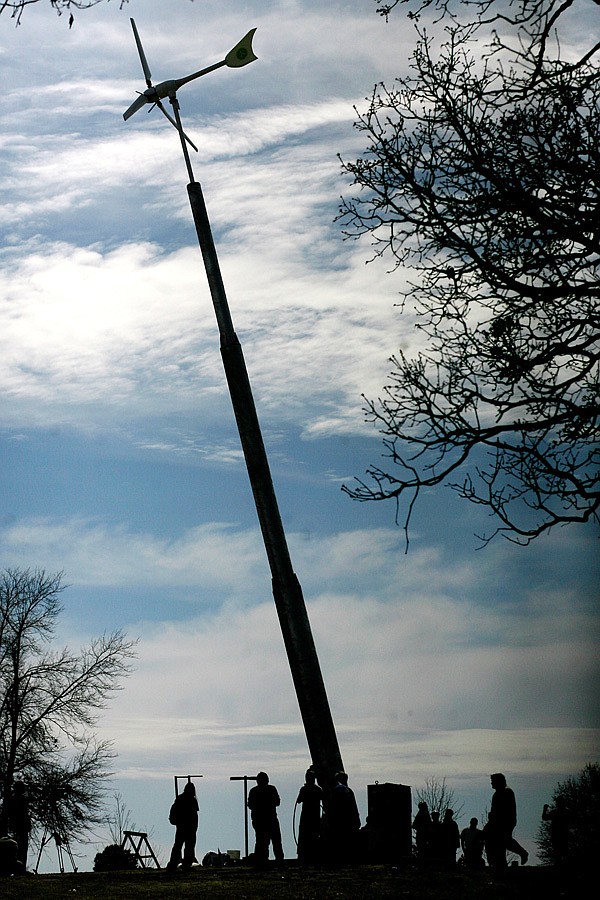60-foot turbine starting to spin, light JBU trail
Students to study wind power
John Brown University students and faculty watch as a 60-foot wind turbine is raised on the Siloam Springs campus. The turbine, which was donated by Sonkyo Energy, will power lights on a walking trail around campus.
Thursday, March 3, 2011
SILOAM SPRINGS — Students and faculty members shielded their eyes and watched as the white blades of the newly installed wind turbine at John Brown University slowly began to turn for the first time Wednesday afternoon. The turbine’s head swiveled, finding a light breeze.
“Now it’s turning,” said Larry Bland, engineering construction manager at JBU in Siloam Springs.
The 60-foot tall turbine is a small part of the effort by universities statewide to increase alternative energy production and to prepare students for a growing demand nationally and internationally for labor and skills in renewable energies - specifically in wind, biomass and solar power.
“This is considered a small turbine,” senior Molli Dickeson said Wednesday. “For here, we’re helping to generate electricity for lights, [but] this could help power a small town.”
The wind turbine will power about 20 lights along a campus trail, Bland said.
Research, innovations and technology developed at campuses statewide could increase residential and commercial use of alternative energy, something Arkansas has grappled to increase for years, said Nick Brown, director of campus sustainibility at the University of Arkansas at Fayetteville.
Despite increasing interest in “green” energy nationwide, Arkansas’ government has failed to create policies, or even a study of which kinds are most effective, that would increase alternative energy use, Brown said. Since Arkansas began looking at alternative energy production about 30 years ago, little has been done, he said.
“We’ve hardly moved the needle,” Brown said.
The state Alternative Energy Commission formed in 2009 but is not funded. It uses volunteers, Chairman Leo Hauser said.
But bills proposed two years ago in the Legislature that would have created renewable fees and tariffs or would require energy providers use a certain amount of alternative energy by an allotted year, failed to move forward, said Chris Denson, state energy office director. Those bills might not be taken up again during this legislative session, he said.
“We’ve been looking at renewable energy incentives,” Denson said.
Arkansas needs an incentive policy for creating and producing alternative energy, according to a July study by Georgia Tech and Duke University.
Arkansas is a top alterna-tive energy producer in its region that includes 15 other Southern states, but the region as a whole lags behind the national average, according to the study.
Despite the lack of incentive policies, Arkansas has attracted four wind turbine manufacturers, which created about 2,300 new jobs, since 2007, said Scott Hardin, spokesman for the Arkansas Economic Development Commission.
The state energy office began a rebate fund for alternative energy last year, a loan program to study wind power in 2008 and has had net metering for individuals since 2001, Hardin said.
UA recently approved a new minor degree program in “sustainability” that begins this fall. In the past few years, the campus has added solar panels that heat its Olympicsize swimming pool. Morepanels went on the Enterprise Building constructed last year. UA has pending patents for research in solar power technology, and at least one company based on UA solar and nanotechnology research started last year, Brown said.
Other universities across the state are studying alternative energy or related technology, state officials said.
At JBU, a private college, the wind turbine adds to a renewable energy program started in 2009 and will help build a work force that could attract more companies dedicated to alternative energy production or could create those companies themselves, Bland said.
“We’re looking to provide the work force of the future,” he said. “[The wind turbine] being one of our key areas, it ties in pretty well.”
JBU students will study how much energy the new Windspot Turbine on campus produces as part of a collaborative effort with itsmanufacturer Sonkyo Energy based in Spain.
The company donated the pilot-sized turbine, estimated to cost $32,000, to JBU, and in a little over a year, it will be replaced with a full-sized one, said Dan Johnson, U.S. managing director of the company.
State officials are focused on promoting biomass (generally plant materials and animal waste used as energy sources) in Arkansas, they said, but officials from UA and JBU said solar power and wind power are also viable. The solar panels on UA buildings and the wind turbine will show the public that commercial applications are doable, Brown and Bland said.
Brown said commercial businesses are watching and waiting to see alternative energy work and be cost effective, but Bland said some residents aren’t ready to embrace wind or solar power.
“It’s a change, and change is difficult for any of us,” he said.
Northwest Arkansas, Pages 7 on 03/03/2011
